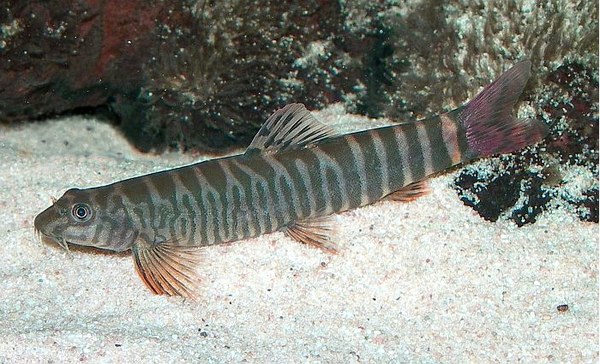Schistura mahnerti
Summary

Scientific name: Schistura mahnerti (Kottelat, 1990)
Common name: Burmese Border Loach, Burmese-border sand loach, Red-tail sand loach
Synonyms: None
Distribution: Salween basin in Thailand. The Salween River originates on the eastern slopes of the Himalayas and forms the border between Thailand and Myanmar (Burma).
Sexual Dimorphism: Males have noticeable suborbital flaps absent in S. vinciguerrae and S. poculi.
Maximum size: 3 inches (7.6cm)
Similar to: S. poculi, S. vinciguerrae, Nemacheilus subfusca.
Care: Schistura mahnerti is a territorial loach like many other Schistura species. Sufficient territories/shelters should be in place if keeping more than one specimen. These loaches are often nippy when defending their particular areas. Try to arrange decor so that it forms visual barriers between territories. Peaceful fish and other peaceful bottom-dwelling fish are not recommended. Ideally, these loaches will thrive in a Brook/Hillstream tank set-up with a high flow rate and well oxygenated waters. More information available here for Brook/Hillstream tanks: Hillstream Loaches: Specialists at Life in the Fast Lane.
Stacked rounded river rocks and large pebbles over a substrate of gravel provide the right kind of shelter for Schistura species and simulate their natural habitat.
Feeding: Like many Schistura species, particles of food moving in the water column or current are snapped up eagerly - quality flake food, bloodworms, brine shrimp, and mosquito larvae.
Water parameters: pH: 6-6.9 Natural waters are slightly acidic. Hardness: Soft Max dh: GH of 2-9dH Well oxygenated waters.
Temperature: 73-79F (23-26C)
Breeding: Some reports of aquarium breedings in Thailand.
Notes
S. mahnerti is highly territorial and should be housed in an aquarium featuring multiple hiding places and decor designed to break line of sight between territories. Do not house with delicate species.
The color pattern is shared with several other Schistura species so positive identification can be difficult. S. mahnerti males have a distinct suborbital flap, which is absent in the very similar-looking S. vinciguerrae and S. poculi. Schistura mahnerti has 9 or more branched caudal rays, unlike S. poculi, which only has 8+7 rays.

Habitat of S. mahnerti, Thailand
Credit: Anuratana Tejavej
Photo Gallery
Click to view all images of this species! |
Document Actions

